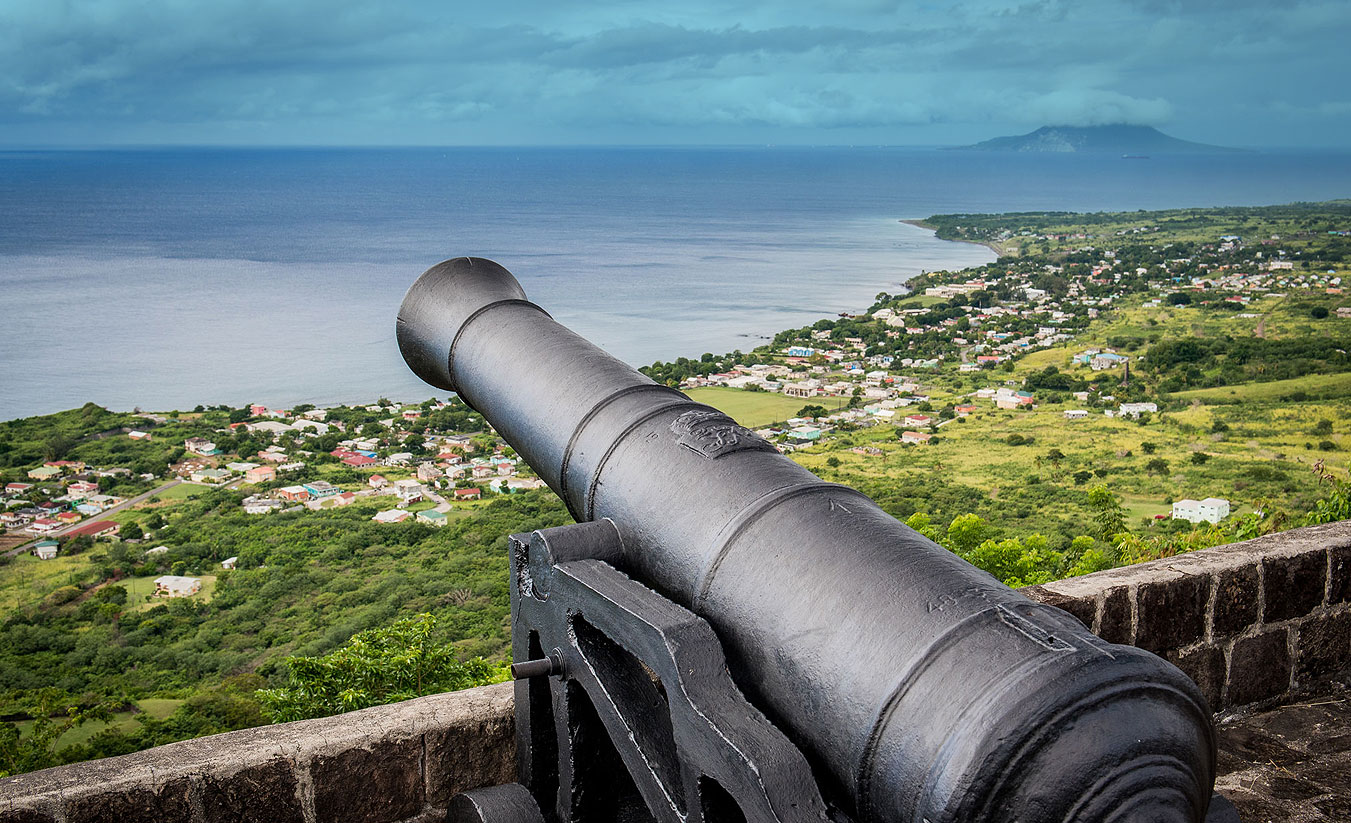Clarence Fitzroy Bryant College
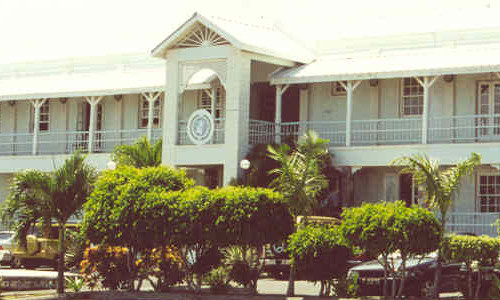
THE CUNNINGHAM HOSPITAL was located on the Western side of Basseterre on land that was now occupied by the the Clarence Fitzroy Bryant College and the Public Library. This was not the first hospital on the island. De Poincy had built one soon after his arrival in 1639 but it was destroyed during the wars of the 17th century.
Health on the Plantation
At a time when the lives of the many were at the mercy of the few the responsibility of caring for the sick and the injured rested within the plantation. The majority of the working population was by law the property of the estate owner who had bought them and as such had to take care of them. In 1784, the Rev. James Ramsay himself a surgeon and Anglican minister in whose charge were the parishes of Christchurch, Nicola Town and St. Johns, Capisterre described the situation in his An Essay on the Treatment and Conversion of African Slaves in the British Sugar Colonies. He also writes about the conditions under which enslaved women gave birth
As the abolition movement gained ground it was felt that measures to show that slaves were well looked after had to be put in place. In St. Kitts this resulted in the passing of a law in 1798 which among other things made provision that every owner or director of slaves shall have under the penalty of one hundred pounds on the estate or place where the slaves usually reside a commodious Hospital or sick house with proper conveniences for the sick and a sufficient number of attendants and shall under the penalty of twenty shillings either in his own person or by some white person under his direction attend as often as may be requisite at the hospital or sick house to see that the sick are furnished with the medicines that may be ordered for them by the said practitioner .. . and also with such diet as the said practitioner or his assistant shall reasonably direct to be given. Passing a law was one thing, enforcing it was another especially since those who would have had to see to its enforcement were planters themselves.
Post Emancipation
The arrival of Emancipation in 1834 forced a rethinking of the situation but it was not till 1848 that St. Kitts had a hospital once again. This came about through the efforts of Charles Thornton Cunningham, Lieutenant Governor of St. Kitts from 1839 to 1847 and housed not only the hospital but also the poor house and the lunatic asylum. The place which was supposed to give refuge to "the destitute and friendless, labouring under the visitations of poverty and disease" was little more than a workhouse. In order to be admitted a patient had to obtain a ticket from the parish vestry. Act No. 673 dated the 20th July 1848 saw to its establishment under the charge of a Master and Matron. These positions were filled William Phipps and Mrs. Phipps who received an annual salary of £60 and £40 respectively. Howard M. Clifton was appointed medical attendant while Thomas Curtis was the dispenser. The actual care of the sick was often left to able bodied inmates, relatives or women with no training or education.
In 1854 a cholera epidemic had wreaked havoc on the new hospital. Dr. John Davy in The West Indies, before and since Slave Emancipation: Comprising the Windward and Leeward Islands Military Command; founded on notes and observations collected during a three years’ residence described the poor conditions at the hospital
Expansion of Facilities
Patients of all kinds were admitted to the Cunningham and conditions became so crowded that in 1872 a small branch was set up in Sandy Point
By 1891 the Cunningham was under the supervision of Dr. W.J. Branch and his assistant. There was also a Dispenser and a housekeeper, 6 day nurses, 6 night nurses all female as well as 4 servants and 4 part time servants all males. Anesthetics prior to surgery were administered through an open mask by the dispenser or the matron. As there was only one medical practitioner at the hospital to see to the needs of the patients, he had to rely heavily on his nursing staff for support.
In 1918 the Nurses hostel at the Cunningham was completed giving each nurse a separate cubicle. It was hoped that since “the decencies of life can be observed” a better class of women could be attracted to the nursing profession.
On the 7th April 1919 the new maternity wing named the Semper ward was officially opened. It housed four beds, a delivery ward, a pantry and a bath and toilet. It was used for all deliveries that were difficult to handle at home. Private wards and a new operating theatre were completed in 1920.
Training and Staffing
Training was further facilitated by the appointment of a full-time Assistant Matron and Midwife. With an act regulating midwifery in place more trained nurses eventually started filling the vacancies at the hospitals and replacing the Nanas (medically untrained but otherwise experienced women who handled deliveries and post natal care) in the community at large thus making community care safer. At this time the nursing staff fell into two groups. The more prestigious positions at the Cunningham in St. Kitts and the Alexandria in Nevis - those of matron, assistant matron and district matron and health visitor were all held by English women. The other section called “native medical subordinate staff” consisted of the positions of the Head Nurse at the Pogson, the Master of the Leper home, the steward and dispenser, nurses, and assistant nurses.
The 1920s brought even further progress which began to reflect on the attitude of both patients and staff. Speaking of the Cunningham in 1923 The Union Messenger stated, “There is an appearance of comfort and happiness on the face of the inmates and the disposition to oblige on the part of the nurses was everywhere in evidence.”
While conditions improved in the hospital a great deal still had to be done in the community. A major concern was that of transporting the sick who would have had to travel “ five, six, or ten miles in quest of hospital attention... in an open wooden cart, drawn by horse, mule or donkey, without protection from the elements.” A major community effort was launched by Dr. J. Cramer and on the 27th of September 1934 the first ambulance arrived in St. Kitts.
Nurses training continued to be a priority but often one that was hampered by the lack of staff and the great deal of work that had to be completed on a day to day basis. Nurses were given a full practical and theoretical course in general training, midwifery and commonsense, the last according to Dr. Gillett being the most difficult to instill.
At this time the profession was open to girls, eighteen years or older who were in possession of a Seventh Standard School Leaving Certificate. Candidates were expected to train in the medical and surgical wards under the supervision of the nurse in charge. There were no lectures and learning came through observation and listening. Textbooks were a scarce commodity. A further six months of training took place on the maternity ward under the Matron’s tutelage and at the end of this period an exam that had been pre-set in England had to be taken. A further upgrade in nursing came in the 1940s with the introduction of a three year nursing education plan, crash courses for nurses who were already on staff and an increase in salaries. Those interested in making nursing a career had to complete training in England. In 1949, May Stevens of Nevis became the first woman from the state to hold the position of Matron of the Cunningham Hospital. In 1949 through aid from the West Indies General Training Scheme, health care staff was provided with training which was to stand them in good stead both at the hospitals and at the new health centres that opened in Basseterre, Cayon and Tabernacle two years later.
Besides the Maternity ward, which was in a separate building, the main structure of the Cunningham Hospital housed a male septic ward and female septic ward downstairs. Adjoining then was the dispensary, a theatre and offices. Upstairs there were male and female aseptic wards, five private rooms, the main operating theatre and a small children’s ward. Mental cases were treated in another building until provision for them was made at the Cardin Home. From 1940 tuberculosis patients were treated in a ward on the upper floor of the same building. By then there were 112 beds The Cunningham continued to serve St. Kitts till 1967, when the J. N. France Hospital was opened. The Cunningham becomes a School
In the years that followed the move to the new hospital, the education system in St. Kitts was undergoing some dramatic changes. One of these involved the setting up of a junior high school and a teachers training college. The buildings of the old hospital were used for the purpose. However as their condition deteriorated and technology became such an integral part of education, it became clear that the structures would suffer from overload and that they had to be replaced. In 1986 a decision was taken to combine the the various divisions of post-secondary education under one administration but this was difficult to accomplish successfully when the physical facilities were not available. In 1996 a new St. Kitts-Nevis College of Further Education was opened on the premises of the old hospital at Burdon Street.. It was organized in four divisions - Teacher Education, Technical and Vocational Education and Management Studies, Health Sciences, Arts, Sciences and General Studies (including Adult and Continuing Education). A division of Hospitality Studies was added later. In 1997 the college was renamed the Clarence Fitzroy Bryant College after the Minister of Education who started the transformation of education in St. Kitts-Nevis.
The complex also became the new home of the public library which had been destroyed in the Court House fire of 1982. In 2000 this building was named the Charles Halbert Public Library in honour of a man who, though not a teacher, attempted to educate the people of Basseterre in matters that were not then part of the education curriculum.
Buckley’s Estate
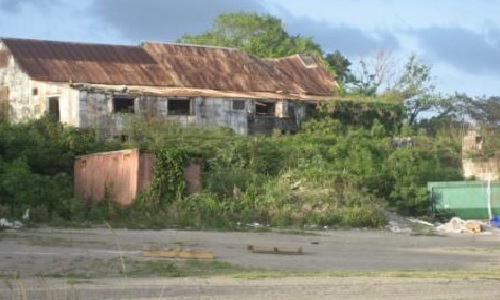
BUCKLEY’S ESTATE is located on the western outskirts of Basseterre.
In 1753 the plantation was the property of William Buckley. His only surviving daughter and heir Jeannette married Abednego Matthew (b. 1724). He was the son of William Mathew who in 1715 had been appointed Lieutenant-General of the Leeward Islands and from 1735 was Captain-General and Commander-in-Chief. His ancestors included other governors of St. Kitts and the Leeward Islands. When Jeannette Mathew inherited the plantation from her father in 1754, her husband became one of the wealthiest planters in the Basseterre region but a bitter divorce cast doubt as to the ownership of the estate for some years.
In 1817, when the first Register of Slaves was compiled, the Mathew’s estates were being managed by Thomas Chambers and employed 130 enslaved persons from very diverse backgrounds. These included thirty seven Africans which were mostly Ibo. Several were from the Congo and a small number were identified as Minna, Mucco, Bambara, Mandingo and Attam, all from the area of West Africa that is now Nigeria and Niger. Matthew was one of the few planters who encouraged the enslaved persons who worked for him to accept baptism. One of the cane fields on his estate was called Negro Church field, which may indicate that somewhere in the vicinity church services were held for the enslaved on Buckley’s.
It is not yet known how the plantation fared in the post emancipations era. In the 1850s the property was owned by George Buckley Matthew, who was a captain in the Coldstream Guards, Member of Parliament for Athlone and Shaftesbury and who also served as a diplomat. By then Matthew also owned Dewar, Diamond, Matthews and Olivees.
In January 1935, just before the start of crop, the workers at Buckley asked for a raise in wages. Those on the Wade estates had received a bonus in December 1934 and the ones at Buckley were expecting something similar. At that time the estate was the property of Brownlow Henry Hamilton Mathew Lannowe (1872-1964 a Lieutenant Colonel in the Dragoon Guards who had served at Ladysmith, South Africa). His manager E.D.B Dobridge refused to consider this request. The labourers went on strike and then started calling out those on other estates. The result was two days of intense labour unrest that was put down with the rifle fire of the defence reserve. It left three dead, nine injured and a number of people under arrest. This was the first of many labour confrontations that were to sweep the Caribbean in the three years that followed. In 1938, the Colonial Office sent out a Royal Commission under the Chairmanship of Lord Moyne to investigate the causes of the disturbances. His recommendations included a revamping of the economy of the islands and the introduction of universal suffrage.
In 1975, after long negotiations with the planters, the Government acquired the sugar lands in an attempt to save the sugar industry from total collapse. The ceremony took place at Buckley’s as a way of turning a place of tragedy into one of victory and to commemorate the lives lost in 1935.
The Berkeley Memorial
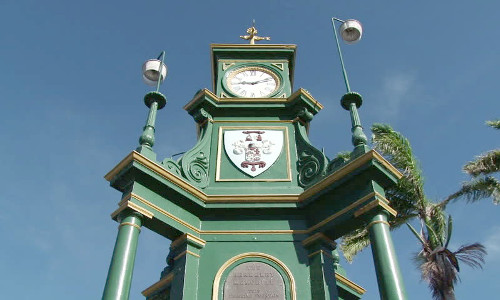
The Berkeley Memorial was erected in 1883 and was for a long time the only public memorial commemorating an individual in St. Kitts. It was dedicated to the memory of Thomas Berkeley Hardtman Berkeley, a legislator and owner of the estates called Fountain, Greenland, Greenhill, Ottleys, Shadwell and Stone Fort.
The structure contains a clock and drinking fountain. It was designed and produced by George Smith and Co of Glasgow, Scotland. Two other similar structures were produced by the foundry but only the one in St. Kitts survives.
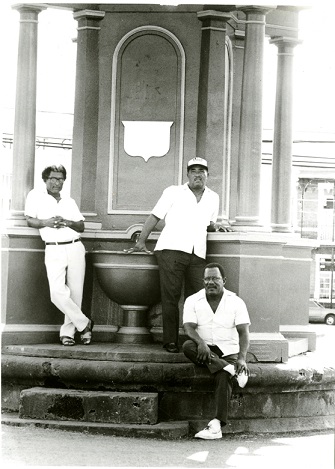
The Fountain
On the 30th March 1859 the House of Assembly addressed Governor Robinson who was temporarily relinquishing his post as Governor-in-Chief of the Leewards and showed its appreciation for the numerous public works that have been executed, such as the supply of water from the mountains to the Town of Basseterre; and in connection therewith, the adornment of the Square with a handsome fountain and Garden; the Pier, The Treasury Building and Light House and the new Church of St. George’s” F. S. Wigley, J. S. Berridge, Archibald P. Burt, R. Challenger and W. Clukies constituted the committee that oversaw water project. The fountain was the monument to its successful completion. It was placed in the only open public space in Basseterre where every one could enjoy it. The figurines at the top of the fountain are decorative nymphs that were then gaining popularity in English country houses. They were inspired by the classical decorations of Italian villas The waste water from the fountain drained into a tank located on a piece of land called Greatheed land (on the corner of the Bay Road and Adlam Street.)
Piped water in Basseterre meant that people did not have to depend solely on water in cisterns. The project solved a problem that had plagued Basseterre for many years but the Committee also recognised that this was only the beginning. It’s report showed that the source at Olivees was not sufficient to provide water in times of drought. It also recognised that it would not provide enough water for it to be piped to individual houses and expressed concern that the stand pipes will cause deterioration of the roads in the town if people were not careful. The report recommended that, to meet the full needs of the town the source at nearby Johnson’s Estate should be tapped into and connected to the pipes already in place from Olivees.
The fountain had uses other than the decorative ones. An article in the St. Christopher Gazette of the 28th March 1862 reports The weather this week is still more sultry than the state we mentioned it to be in our former impression. Everything connected with animal subsistence seems to be suffering from the cause alone. And the want of water is so severely felt by all, that persons are now compelled to resort to the old custom of obtaining water from the many wells which were altogether abandoned on the erection of a fountain in Pall Mall Square and the opening of dams in town.
The fountain had become a major source of water for many in Basseterre. Its cool, refreshing, running water must have been like a magnet on hot dry days. However, as anticipated by the Committee, it was just the start of dealing with the problem of water in a densely populated urban area. On the night of the 2nd July 1867 a fire broke out in a bakery that was located on the corner of Central Street and West Square Street and quickly engulfed the town destroying over five hundred houses leaving close to 5000 persons homeless. Businesses came to standstill as their merchandise had been destroyed. The newly reconstructed St. George’s Anglican Church was a smouldering ruin. On this occasion the pipe bourn water that the fountain celebrated was, as predicted by the Committee ten years earlier, inadequate to deal with the calamity. Once again it took a major disaster to spur the Council into a decision to enhance the water supply to the overcrowded town.
Today with water reaching each individual household in Basseterre and with a decent Fire Service in operation, the significance of the fountain in Independence Square has been largely forgotten. Yet it continues to be a source of calm and tranquillity to the many people who pass through the square and especially to those to stop there to enjoy a few moments of gentle silence under the trees.
JNF Hospital
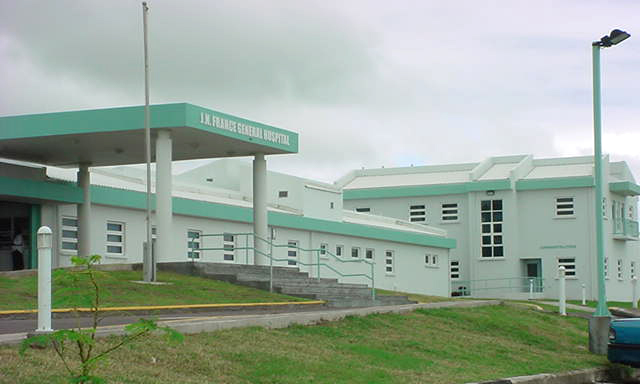
by Sonia Daly-Finley, Director, Institutional Nursing Service
Under the auspices of the Ministry of Education, Health and Welfare, construction of The Joseph Nathaniel France (JNF) General Hospital began in March of 1966 and was expected to be completed in September 1967. The master plan for the Hospital was prepared by Sir John Weekes of Llewellyn Partners, United Kingdom. The facility was built by Clarence Johnson Construction Company Limited of Antigua while the Architect, Mr. Colin Laird, of Trinidad visited and gave advice. Also, Mr. L.G. Felipes, Managing Director of the British Engineering Manufacturing Alliance, visited on a monthly basis from his base in Trinidad. Additionally, Mr. R. Joseph, Inspector or Clerk of Works for the Public Works Department, St. Kitts, supervised the work on the Hospital.
The Hospital was built on lands belonging to Buckley’s Estate at a cost of $2.2 million (E.C); this included the cost of the land. While under construction, His Excellency Mr Fred Phillips, C.V.O., Minister of Education Health and Welfare – Mr. Fitzroy Bryant along with members of the Health Planning Committee for St. Kitts, paid a visit to the site on March 11, 1967. At that time, the members of the Health Planning Committee were:
- Permanent Secretary, Min. of Education, Health and Welfare - Mr Anthony Rebeiro
- Principal Assistant Secretary - Mr Maurice Woods
- Chief Medical Officer - Dr. J. O’Keefe
- Medical Superintendent, Cunningham Hospital - Dr Cuthbert Sebastian
- Representative of the British Medical Association (Local Branch) - Dr Arthur Lake, O.B.E
During a thirty (30) minute guided tour by Mr. R. Joseph, Clerk of Works, they visited the twenty-four (24) bed Maternity Block, the twelve (12) bed Private Ward, Xray and Theatre. At that time, it was felt that the estimated date of completion, late September 1967 was achievable. Upon leaving the construction site of the new hospital, the gentlemen visited the Cunningham Hospital where they pondered the best use of the facility after the transfer.
The new facility was officially handed over to the Government on October 28, 1967. The Hospital was commissioned for use on December 14, 1967.
At the opening ceremony on December 14th were local Ministers of Government, visitors from overseas and Miss May Stevens, the former Matron of the Cunningham Hospital. Addresses on this auspicious occasion were delivered by:
- The Governor - Sir Fred Phillips
- The Premier – Mr. Robert Llewellyn Bradshaw
- The Deputy Premier - Mr. Caleb Paul Southwell
- Minister of Education, Health and Welfare – Mr. Fitzroy Bryant
- Chief Medical Officer – Dr. J. O’Keefe
The vote of thanks was given by Dr. Cuthbert Sebastian who was then the Medical Superintendent. Mr. Anthony Rebeiro, Permanent Secretary, Ministry of Education, performed the duties of Master of Ceremonies.
In his speech, Premier Bradshaw said that the “Hospital belongs to the people of the entire State. It was financed by grants not only from overseas but from the Sugar Stabilization Fund and the Sugar Industry.”
The Hospital was named after Mr Joseph Nathaniel France, a Minister who was without portfolio at that time and who was formerly the Minister of Social Services. It was the intention to occupy the hospital in January 1968. However, removal of the patients and equipment from the Cunningham Hospital began on March 04, 1968 and was completed during that week. The new Hospital, The JNF General Hospital, did not begin services to the public until Sunday, March 10, 1968. The JNF General Hospital replaced the Cunningham Hospital which was in existence from 1848.
The JNF General Hospital which opened with one hundred and six (164) beds was said to have “top class facilities for a hospital of its size.” The new features included:
- The Maternity Unit which was the “finest to be found anywhere” and it was said to be four (4) times the one at the Cunningham Hospital. Attached to it was a proper Labour Suite with two (2) delivery rooms and an Operating Theatre.
- The Surgical Theatre was said to be very modern.
- The Surgical Ward was intended to have an Intensive Care Unit.
- The Casualty and Out-patient Department was designed to offer better organised service.
- The kitchen was said to be one of the finest and contained “acme in equipment.” Allowance was made for a cafeteria service.
- The laundry was said to be excellent and was “a first in modern electrical equipment.”
- The Central Sterile Supplies Department (CSSD) was “a completely new concept in this State”. It was expected that everything to be sterilised would have been done in CSSD and then distributed to the Wards and other departments.
At that time, persons who were receiving an income of $3,000.00 per annum or over were expected to pay hospital fees while those receiving less than $3,000.00 per annum were eligible for free medical care in “free beds” at the hospital. The fee structure was as follows:
- Private Ward
- Single-bed room with wash basin - $ 5.00
- Two-bed room - $ 3.00
- Medical and Surgical Blocks
- Single-bed room - $ 2.00
- Four-bed room - $0.50
- Maternity Block
- Single-bed room with bath, lavatory and air-conditioning - $10.00
- Single-bed room with bath and lavatory - $ 8.50
- Single-bed room with wash basin and air-conditioning - $ 6.00
- Four-bed room - $ 1.00
- Children’s Block
- Single-bed room - $ 3.00
- Two-bed room - $ 2.00
All patients who were covered by medical insurance were automatically considered fee paying patients. Non-residents were classified as fee paying patients. Fee paying patients were charged a Theatre fee for operations and were expected to meet the cost of expensive drugs. Outpatients, except those who were entitled to free medical attention, were expected to pay fees for Xray and laboratory services.
In an effort to lend support to the staff and patients at the new hospital, fifteen (15) women met and established a voluntary organization called ‘Friends of the Hospital’. The first meeting was convened on Wednesday, March 13, 1968, at the Nurses’ Classroom, at The JNF General Hospital. The women were:
- Mrs. O. Audain
- Mrs. R. L. Bradshaw
- Mrs. W. DuBuisson
- Mrs. A. M. Edwards, M.B.E
- Mrs. E. Glasgow
- Mrs E. Jacobs
- Mrs. L. Kassab
- Mrs. A. Osborne
- Mrs. L. Richardson
- Mrs. S. Sebastian
- Mrs. C.A.P. Southwell
- Mrs. G.O. Ward
- Mrs G.E. Warner
- Mrs. F.T. Williams
Mrs. DuBuisson, wife of the Chairman of the Board of Directors of the St. Kitts Sugar Factory, was elected as the Honorary Chairman while Mrs. Audain was elected chairman. Mrs Glasgow was elected Secretary and Mrs. Kassab Treasurer.
It was decided that the primary functions of the group would be social work and fund raising for the hospital. As part of the fund raising exercise, a “Shop on Wheels” was introduced. The trolley was donated by the Sugar Factory.
The Honorary Chairman, Mrs. DuBuisson, had shown great interest in the Cunningham Hospital for many years. In fact, she was a member of the managing committee of the St. Thomas Hospital, London, England, for thirty (30) years. It was therefore planned to establish linkages with similar groups in the United Kingdom.
Shortly after the Hospital was opened, Mrs. DuBuisson presented the Matron, Mrs. Louisy Walwyn, with a cheque for 50 (pounds) to help with the furnishing of the Nurses’ Lounge at the new Hospital. Dr. Charles Jong of Taylor’s Site also made a donation of a cheque for $100.00 to The JNF General Hospital[1].
In 1998, following the devastation of The JNF General Hospital by Hurricane George, rebuilding of the Hospital, on the same site, began in phases. Phases I and II of the new structure was erected at the front or southern end of the old structure. The Paediatric Wing was built as a United Agencies for International Development Hurricane George Project 2001. It was commissioned on March 18, 2002. The other Units, with the exception of the Private Ward were commissioned on January 30, 2003. The Private Ward was completed and commissioned on February 23, 2004.
From the vantage point of the JNF General Hospital, secondary health care delivery has made significant strides over the years, especially during the last two (2) decades. The service has seen the inclusion of:
- The Emergency Medical Services
- Formal Quality Improvement Strategies
- Formal Neonatal Care
- Formal Intensive/Critical Care Service
- Twenty-four (24) hour coverage by Medical Officers at the Accident and Emergency Department
- Asthma Care
- Haemo and Peritoneal Dialysis
- Admission and Discharge Planning
- Improved Ophthalmology Services
- Endoscopic Services
- Computerized Tomography (CT Scan)
- Magnetic Resonance Imaging (MRI)
- Specialized Orthopaedic Services
- Plastic/Reconstruction Surgery
- Counselling Services
- Foot Care Services
- Pain Management Services
- Oncology Services
- Vascular Surgery
- Full Implementation of the Services of the Central Sterilizing and Supplies Department
- In-service Education programmes to facilitate formal ongoing training for all health care providers
As we stand at the threshold over the fiftieth anniversary, we anticipate further expansion of the health care services to include basic cardiology and advanced vascular surgical interventions. We also envisage that the majority of the Junior Nurses will enter the system as Degreed nursing personnel and that the Emergency Medical Technicians will be trained at the intermediate level.
As Chair of the Fiftieth Anniversary Planning Committee, I extend gratitude to the committee members for the unswerving support in the planning and execution of the celebratory activities. I also extend gratitude to all other members of staff who assisted in the planning and execution of the activities. Profound gratitude is extended to the Honourable Wendy Phipps who encouraged and guided the process.
Profound gratitude is extended to all health care providers; we thank you for your service to mankind. To our pioneers, those who have paved the way for the present generation of health care providers, we are also profoundly grateful to you. We thank you for your support, foresight and guidance.
And, to the Almighty, we are grateful that he has brought us thus far. May He continue to bestow us with the wisdom and strength to meet the health care needs of our people as we endeavour to live up to our motto, “People First, Quality Always.”
National Archives
Government Headquarters
Church Street
Basseterre
St. Kitts, West Indies
Tel: 869-467-1422 | 869-467-1208
Email: NationalArchives@gov.kn
Website: www.nationalarchives.gov.kn
Follow Us on Instagram

